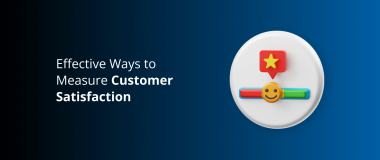Customer loyalty is one of the most crucial aspects of any business. It’s far more cost-effective to retain existing customers than to acquire new ones – about five times cheaper, in fact. That’s why establishing loyalty and retention is paramount to reducing expenses. Businesses often achieve this through loyalty programs, affiliate marketing, providing discounts on future purchases, and other smart strategies.
In 2023, it is vital to stay up to date with your customers’ desires and understand what truly appeals to them in order to build an effective customer loyalty program.
That’s why we’ve curated this blog post, outlining the essentials of a customer loyalty program, what has changed in 2023, as well as the current trends when creating a reward program. There will also be a step to step guide on how to craft a seamless, state-of-the-art program. Keep reading to level up your loyalty game.
What Is a Customer Loyalty Program?
A customer loyalty program, also known as a loyalty reward program, is a retention strategy that motivates customers to keep purchasing from your company rather than from the competition.
Readers also enjoy: How Brand Recognition Helps You Improve Customer Retention – DevriX
4 Benefits of Loyalty Programs
More than 90% of businesses have embraced some form of a loyalty program, and there’s a solid rationale behind it: successful customer relationships flourish when both parties benefit mutually.
Here are some of the advantages of building a customer loyalty program:

- Boosts the company’s revenue. When customers become loyal to a brand, they are less likely to leave and more likely to keep on buying from you. For instance, many customers make additional purchases to reach a higher tier in a program or to receive a discount.
- Increases customer lifetime value and retention. By rewarding loyal customers for their purchases, they are more likely to return. Additionally, when customers have a positive brand experience, they become more satisfied, allowing you to establish connections not only with existing customers but also with new ones.
- Differentiate a brand from the competition. With a customer loyalty program, you stand out from other brands. It gives your customers that extra nudge to connect with your brand and enjoy the rewards from snagging products from you at a better price than from the competition.
- Boots customer’s engagement. Want to boost customer engagement? A loyalty program is the key. As a matter of fact, inviting the customer to participate nurtures the relationship between both sides and reinforces the notion that you truly value your clients.

Types of Customer Loyalty Programs
There are various types of customer loyalty programs that you can utilize. Let’s briefly mention them:
- Points-based programs. These are among the most popular types of customer loyalty programs because points are easy to earn and redeem. Customers can redeem their points for credits toward future purchases, discounted services, freebies, etc.
- Tier-based programs. When customers reach a certain spending level, they unlock a new tier with additional benefits. For instance, reaching the “gold” customer tier grants them exclusive pricing on your premium products and services.
- Goal-based programs. Not all reward programs focus on tiers and discount codes. If your company is strongly mission-oriented, you may consider adopting a customer loyalty program that supports a cause.
- Spending-based programs. These programs ensure that businesses recognize customers who make larger purchases. Airlines, in particular, are transitioning from points-based programs to ones that focus on spending. This shift enables them to engage more effectively with travelers who spend higher amounts on fewer flights.
- Game programs. Game programs, gamification, or simply games add excitement to the shopping experience. They include simple things like “spin and win,” where customers can play to win rewards. Moreover, the rewards can be anything, discounts, more reward points, a chance to win a trip or groceries for a year, free items or store products.
- Subscription programs. A subscription program, also known as a premium loyalty program, requires customers to subscribe and pay an upfront fee for a product or service, in return for rewards. These rewards can be redeemed and used for things like future purchases.
- Community-based programs. These programs enhance customer engagement and can stem from an existing loyalty program. For instance, within a loyalty program, online clubs and groups can be created, providing the brand with the opportunity to communicate more directly with customers.
- Referral programs. Referral programs reward customers for inviting the others, turning loyal customers into brand advocates. This word-of-mouth strategy encourages repeat business and expands the customer base.
- Paid programs. In a paid loyalty program, customers pay a fee to enjoy exclusive benefits and receive continuous advantages. For instance, they can opt for a $10 monthly subscription that grants them a discount on their purchases every month.
- Cashback programs. Cashback reward programs provide customers with cashback or money to spend at the company, creating a sense of reciprocity for their spending.
Readers also enjoy: A Comprehensive Guide to B2B Loyalty Programs – DevriX
What Has Changed for Customer Loyalty Programs in 2023
In February 2023, PwC conducted the “Global Consumer Insight Plus Survey,” which provided valuable insights into the main factors currently reshaping loyalty programs.
If you are considering starting a customer loyalty program or adapting your current one, you need to take these into consideration:
- Inflation deflates sentiment. Inflation has impacted rewards programs globally, making consumers more price-sensitive and less interested in loyalty programs without tangible benefits.
- Consumers live in a “phygital” world. In a “phygital” world, consumers engage with brands across various channels, blending physical and digital experiences. This shift has reshaped customer interactions, demanding seamless online and offline experiences from businesses.
- Supply chain disruptions. The ongoing supply chain disruptions caused by the pandemic have had a lasting impact. Companies still face challenges in maintaining inventory levels, often leading to limitations in their rewards programs. Nevertheless, companies that have successfully adjusted to the new reality by providing alternative rewards and incentives, such as virtual events and experiences, have managed to sustain customer engagement and loyalty.
5 Key Customer Loyalty Trends to Watch Out for in 2023
From personalized experiences to gamification and flexible reward options, these trends are changing how businesses engage and retain customers in 2003:
Gamification
With about 80% of Millennial and Gen Z consumers being avid video game players, it’s important to incorporate gamification into your loyalty program. This means adding game-like elements that resonate with your audience and keep them coming back for more rewards. By infusing fun and interactivity into the reward experience, you can enhance customer engagement and create a digital experience that truly connects with your customers.
These elements could include developing a user-friendly app where your customers can easily track their rewards, earn referral bonuses, access exclusive discounts, and even get a sneak peek of upcoming perks and rewards through a countdown timer. This not only adds excitement but also builds anticipation and actively involves your customers in the process.
Personalisation
Personalization has become one of the hottest trends in the world of rewards programs, as 71% of customers now prioritize businesses that provide personalized experiences. This shift in consumer behavior highlights the importance of tailoring your loyalty programs to meet individual preferences and needs. By embracing personalization, you can not only attract more customers but also foster stronger brand loyalty and drive higher sales.
Imagine a space where members have exclusive access to personalized dashboards showcasing their points data and that offers various ways to redeem their rewards.
Mobile Apps
The growing trend of customer loyalty programs includes the creation of mobile apps which can be approached in various ways. One approach is to develop a mobile app for shopping, providing a seamless omnichannel experience while gathering valuable customer data related to their shopping behaviors.
Alternatively, you might consider developing a dedicated app or incorporating a section within your existing app specifically for your brand’s loyalty program. This allows loyal customers to easily track their progress and view their accumulated points.
Loyalty Partnerships
Instead of solely relying on their individual loyalty programs, brands are joining forces to offer combined benefits and reach a wider audience.
In a loyalty partnership, two or more brands collaborate on a shared loyalty program, providing incentives to customers from each participating brand. While the concept itself is not new, it has gained momentum recently .
Flexibility
Customers today value the freedom to choose how they redeem their rewards. Loyalty programs that impose restrictions on specific items run the risk of losing their loyal customer base. By offering a good amount of flexibility, you can cater to your customers’ preferences and enhance their overall loyalty to your brand. For example, you can give customers the freedom to earn rewards with every purchase they make.
Readers also enjoy: 3 Secret Tips to Happy Client – DevriX

10 Steps on How to Create a Customer Loyalty Program in 2023
Creating a customer loyalty program that truly succeeds is a continuous journey. It involves constantly keeping an eye on your customers’ ever-changing needs and adapting accordingly. Let’s break down this process into 10 steps to help you navigate the path to success:
Set Clear Objectives
Determine the goals and objectives of your loyalty program. Define what you want to achieve, such as increasing customer retention, driving repeat purchases, or enhancing customer engagement.
Understand Your Target Audience
To really understand your target audience for your loyalty program, you need to get in touch with them. Start by doing some market research and collecting customer insights. Look at their demographics, preferences, and behaviors by analyzing customer data. Don’t be hesitant to reach out to them directly through surveys, focus groups, or interviews to get their feedback. Keep an eye on what they’re saying on social media and on online reviews to understand them and their problems better. And of course, use analytics tools to track how they interact and behave on your platforms.
Stay Updated on Current Challenges and Conduct Thorough Analysis
To stay on top of current challenges and thoroughly analyze your loyal customer program, it’s important to keep an eye on industry trends and how your customers behave. Make the most of data analytics so you can gather valuable insights and assess the performance of your program. Don’t forget to actively seek feedback from your customers and make necessary adjustments. Stay agile, responsive, and committed to ensuring long-term success.
Keep Up with The Current Trends
Stay continuously informed about industry developments through research, industry publications, and by attending relevant events. Keep a close watch on your competitors and analyze the successful loyalty programs in your market. Adapt your strategies accordingly to ensure you remain relevant and competitive in the ever-evolving landscape of customer loyalty.
Define Your Type of Loyalty Program
When defining the type of loyalty program, use the data from your target audience. Consider their buying behavior, interests, and motivations. Determine whether a points-based program, tiered program, paid program, or a combination would be most effective. Loyalty partnerships options should align with your brand values and objectives to create a unique and compelling offer.
Readers also enjoy: Effective Ways to Measure Customer Satisfaction – DevriX
Choose the Right Platform
Select a platform or the technology that enables seamless program management and enhances the customer experience. This could be a mobile app, website, or integrated software solution. With this in mind, keep it simple and user-friendly, especially if your budget is limited.
Design Compelling Rewards
Create rewards that excite and motivate your customers. Also, consider offering personalized rewards that align with their preferences and make them feel valued.
Promote and Communicate
Develop a marketing and communication strategy to raise awareness about your loyalty program. Use multiple channels to promote the program, engage customers, and highlight the benefits and rewards they can enjoy.
Monitor and Analyze
Continuously monitor the performance of your loyalty program. Also, track customer engagement, redemption rates, and overall program effectiveness. In addition, analyze data to identify areas that need improvement and make adjustments accordingly.
Evolve
Keep your loyalty program fresh and exciting by regularly introducing new rewards, features, or exclusive offers. Also, adapt to ever-changing customer preferences and market trends to ensure ongoing success.
Wrap Up
Creating a successful loyalty program in 2023 requires understanding customer needs, personalization, embracing new trends like gamification and mobile apps, offering reward flexibility, and staying updated on industry challenges. By following the steps above, businesses can build a thriving loyalty program that drives customer engagement and boosts brand loyalty.




